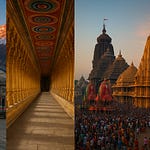Nestled amid the craggy hills of the Eastern Ghats in Andhra Pradesh's Kurnool district, lies a sacred temple so enigmatic, it leaves both historians and devotees awestruck. This is the Yaganti Uma Maheshwara Temple, home to one of India’s greatest living mysteries — the growing stone Nandi, locally revered as Basavayya.
From ancient Dravidian carvings to unexplained architectural oddities, Yaganti is not just a temple — it is a living portal into a dimension where devotion, prophecy, and the inexplicable converge.
📜 Origin and Foundation of Yaganti Temple
The temple traces its origins to the 5th century, but it was built and expanded during the 15th century by King Harihara Bukka Raya of the Vijayanagara Empire, one of the most powerful Hindu dynasties in South India.
🧙♂️ The Saint Behind the Temple
The site’s spiritual legacy is intricately tied to Sage Agastya, one of the Saptarishis. It is believed that Agastya chose this serene location to perform intense penance to Lord Shiva. He desired to install a Shiva Lingam here, but the idol he found had a broken nose — considered inauspicious.
Disheartened, he meditated, and Lord Shiva himself appeared and assured him he would manifest here in the form of Ardhanareeshwara — a composite form of Shiva and Parvati.
Hence, the deity at Yaganti is Uma Maheshwara, representing the inseparable divine masculine and feminine.
🐂 The Growing Nandi (Basavayya) — A Living Mystery
Perhaps no other Nandi idol in India has inspired such awe and mystery. The Nandi at Yaganti, fondly called Basavayya, is:
Carved out of a single black granite stone
Placed outside the sanctum sanctorum — but unusually faces away from the Shiva Lingam
Said to be growing every year — a phenomenon supported by archaeological observations
📐 What Does Science Say?
According to Archaeological Survey of India (ASI), the Nandi idol increases in size by a few millimeters every year. The gap between the Nandi and the temple walls is reportedly shrinking, and the circumambulatory path (pradakshina) has been blocked to prevent damage.
Scientists have posited theories ranging from hygroscopic expansion (stone absorbing moisture) to mineral accretion, but none have offered conclusive evidence.
🔮 Kalagnanam Prophecy
The phenomenon aligns with the Kalagnanam, an ancient prophetic scripture written by Sri Potuluri Veera Brahmendra Swamy, which foretells that:
"The Nandi at Yaganti will eventually come to life when Kaliyuga reaches its peak."
This belief elevates Basavayya beyond an idol — he is considered a living being, growing in preparation for a divine future.
🕉️ Spiritual Significance of Yaganti
🔱 Lord Shiva as Uma Maheshwara
Unlike most temples dedicated solely to Shiva, here the deity is seen in his Ardhanareeshwara form. This denotes balance: of destruction and creation, of masculine and feminine, of power and compassion.
🌿 Pushkarini: The Sacred Pond That Never Dries
A rare wonder of nature is the Pushkarini, a temple pond that is fed by an underground spring and never dries, even during the harshest summers. The water is considered highly sacred and believed to contain healing properties.
🙏 Puja and Ritual Practices at Yaganti
The temple follows Shaivite traditions, with a daily schedule of rituals, abhishekams, and bhajans that nurture both the soul and the senses.
🕯️ Daily Rituals
Suprabhatam (early morning awakening of the deity)
Abhishekam with sacred water, milk, ghee, curd, and honey
Alankaram with flowers, rudraksha, sandal paste
Archana (chanting of 108 names)
Aarti at various intervals — morning, noon, and night
Nandi Seva and Annadanam to devotees
🎶 Bhajans and Spiritual Chants
The temple resonates with Shaiva bhajans, particularly in Telugu and Sanskrit. Devotees often sing "Om Namah Shivaya," "Uma Maheshwara Stotram," and "Lingashtakam." During Maha Shivaratri, all-night bhajan sessions and Rudra homams are conducted.
🪔 Special Festivals and Aarti
📅 Maha Shivaratri
The temple draws thousands of devotees for Maha Shivaratri, observed with:
Abhishekam of 11 kalashas
Night-long chanting of Rudram
Nandi Ratha Yatra
Lighting of thousands of lamps
🌺 Karthika Masam
A sacred month in the Hindu calendar when:
Deepa Aradhana (lamp offerings) is performed
Special poojas for health and prosperity are organized
Women observe Deepa Vratams in reverence to Parvati Devi
🚶♂️ How to Visit Yaganti — A Travel Guide
🗺️ Location
Yaganti Village, Banaganapalle Mandal, Kurnool District, Andhra Pradesh
Surrounded by Yerramala Hills, providing a serene, almost mystical setting
🛤️ How to Reach
By Road: Easily accessible by road from Kurnool (100 km) and Nandyal (50 km)
By Rail: Nearest railway station is Banaganapalle (16 km)
By Air: Nearest airport is at Kurnool Airport (~90 km)
🏨 Accommodation
Basic dharmashalas, guesthouses, and a few small hotels are available. Pilgrims often choose to stay in Banaganapalle or Kurnool for better facilities.
🧘♀️ Devotee Experiences and Beliefs
Devotees across generations believe:
Basavayya listens — many offer coconuts, flowers, or handmade clay bulls as tokens of gratitude.
Visiting Yaganti during tough times removes obstacles, frees one from debts, and blesses families with children.
Many speak of miraculous recoveries from illnesses after bathing in the Pushkarini and performing Rudrabhishekam.
🏯 Unique Temple Architecture and Features
Built in Dravidian style, with elaborate pillars, mandapas, and carvings of sages and celestial beings
The sanctum is cut into the mountain rock itself, a rare architectural marvel
Cave temples of Agastya Muni, Veera Brahmendra Swamy, and other saints are located nearby
Yaganti — Where Stone Breathes and Prophecy Whispers
Yaganti is not just a destination. It is a living legend, a spiritual riddle, and a sanctum of divine presence. With the mysterious Basavayya at its heart, it challenges our notions of life, time, and divinity.
To the devoted eye, Basavayya is not growing — he is awakening.
To the seeker, Yaganti is not just a temple — it is a gateway to eternal truths.
Deity: Uma Maheshwara, representing the Ardhanareeshwara form — a divine fusion of Lord Shiva and Goddess Parvati.
Famous For: The mysteriously growing Nandi (Basavayya), ancient cave shrines, and the sacred Pushkarini (temple pond that never dries).
Established By: King Harihara Bukka Raya of the Vijayanagara Empire during the 15th century.
Location: Yaganti village in Banaganapalle Mandal, Kurnool District, Andhra Pradesh.
Mystery: A monolithic stone Nandi (Basavayya) that grows in size every year, baffling archaeologists and scientists alike.
Prophecy: As per the ancient Kalagnanam scriptures, the Nandi at Yaganti will eventually come to life at the peak of Kaliyuga.










